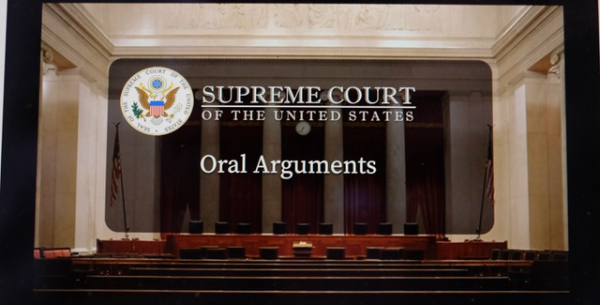
The bump stock, a simple ,device once considered a novelty with shooters, was the focus of ninety minutes of occasionally “spirited” arguments Wednesday in the United States Supreme Court.
Case 22-976 Garland V. Cargill, hinges on a single question:
“Whether a bump stock device is a ‘machine gun’ as defined in 26 U.S.C. 584(b) because it is designed and intended for use in converting a rifle into a machine-gun, I.e., into a weapon that ‘fires automatically more than one shot’ ***by a single function of the trigger.”
For years, bump stocks were legal. Most “serious” shooters considered them toys, not tools.
Then a psycho used bump stock-equipped rifles to kill 60 and wound 500 others at a Las Vegas concert.
In response, the Trump administration, with the support of the NRA, ordered the ATF to “do something” about bump stocks. The ATF complied, changing a longstanding administrative ruling to say bump stocks had now becomemachine guns.
On March 26, 2019, after a grace period to allow the hundreds of thousands of bump stock owners to surrender or destroy their copies, the new administrative ruling classifying them as machine guns went into effect.
Rather than become an “instant felon” Michael Cargill, owner of the Central Texas Gun Works outside Austin, surrendered his store’s inventory of bump stocks, along with two others he’d bought in April of 2018.
Cargill said he relied on the ATF’s longstanding ruling that bump stocks were legal to own and use. So he, along with the New Civil Liberties Alliance, filed suit in the Fifth Federal District Court challenging the ATF’s reclassification of bump stocks and seeking the return of his inventory and property.
Their case argued that federal law clearly says “machine gun” shoot multiple bullets “automatically” and “by a single function of the trigger.” (Function emphasis added).
Bump stocks, they argue, do not modify a trigger or remove the need for the trigger to function for every round fired. Bump stocks only enabled experienced users to pull triggers more efficiently.
In fact, they argued, bump stocks introduced a secondary action, requiring shooters maintain constant forward force on the front of the bump stock equipped rifle. Without the forward pressure in the off hand, a semi-automatic rifle -even with a bump stock- was only capable of firing a single round with a single trigger pull.
Consequently, they argued, the court should rule against the ATF’s reclassification. Using the law as written, the Fifth Circuit agreed.
They also noted the law was “unclear” - and that lack of clarity invoked the rule of lenity, a legal rule that requires courts to interpret “ambiguous” criminal laws “in the way most favorable to defendants.”
The Sixth Circuit heard a separate challenge. Because the law failed to “clearly and unambiguously prohibit bump stocks” the Sixth Circuit also agreed the rule of lenity applied, finding it was “bound to construe the statute” in the defendant’s favor.
The Court of Appeals for the District of Columbia disagreed. It upheld the ATF’s reclassification, finding a bump stock to be “a self-regulating mechanism that allows the shooter to shoot more than one shot through a single pull of the trigger.” It was, they found, a “machine gun.”
The Biden administration asked the Supreme Court to review the rulings by the 5th and 6th Circuits striking down the rule. Bump stock owners in the D.C. Circuit also wanted review of that court’s ruling against them.
The Supreme Court exists to clarify and interpret differing opinions between lower courts.
Based on the arguments yesterday, there will be neither a rapid nor unanimous interpretation.
The justices were divided on the definition of a machine gun and applicability of the law-as written- to bump stocks.
There was also concern regarding the ATF’s change of its prior rulings. Allowing that change, Justice Kavanaugh said, would “ensnare a lot of people who are not aware of the legal prohibition.”
Justices Amy Coney Barrett and Neil Gorsuch indicated they might be sympathetic to the ban, but expressed overarching concerns regarding over the ATF’s reinterpreting the law unilaterally via an administrative ruling -rather than Congress rewriting and clarifying the law.
“I’m sympathetic to your argument,” Justice Barrett said, then asking government attorney Brian Fletcher why Congress didn’t see fit to pass legislation “to make this covered more clearly.”
The specific argument hinges on interpretation of a law as written in 1938 - for the answer to a very specific contemporary question: “does a bump stock constitute a machine gun?”
The law, as written, says a machine gun is a weapon that “fires automatically more than one shot by a single function of the trigger.”
To uphold the ATF change, a majority of the justices must agree that “function of the trigger” must be expandable to cover the entirety of the firing process. Justice Jackson going so far as to describe it as “the chemical process that ultimately expels a projectile.”
Cargill and the NCLA argue a bump stock does not fit the statutory definition of a machine gun- a weapon that “fires automatically more than one shot by a single function of the trigger.”
Without the secondary act of a shooter exerting pressure on the forward portion of the rifle, they argue, a bump stock-equipped rifle will fire only a single shot.
The semi-automatic trigger, unmodified on a bump stock-equipped rifle, won’t magically change a semi-automatic rifle into a machine gun. It only helps shooters perform the one-pull/one round act more efficiently.
The administration disagrees, saying the “function” of the trigger should include the entire act of firing the rifle.
That’s the essence of the argument.
If the high court decide bump stocks -as defined by the statute- are not machine guns, that ruling has the potential to limit the federal government’s ability to interpret -or re-interpret- other ambiguous laws.
If they decide in favor of the ATF’s reinterpretation, they risk creating “instant felons” across the country.
We’ll keep you posted.
— Jim Shepherd